Mikveh Israel
Mikveh Israel (Hebrew: מִקְוֵה יִשְׂרָאֵל, lit. 'Hope of Israel') is a youth village and boarding school in the Tel Aviv District of central Israel, established in 1870. It was the first Jewish agricultural school in what is now Israel and indeed the first modern Jewish settlement in Palestine outside of Jerusalem, heralding a new era in the history of the region.[2] In 2021 it had a population of 378.[1]
Mikveh Israel
מִקְוֵה יִשְׂרָאֵל | |
|---|---|
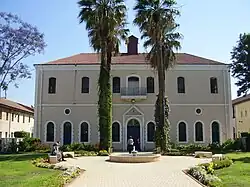 Mikveh Israel | |
| Etymology: Hope of Israel | |
 Mikveh Israel  Mikveh Israel | |
| Coordinates: 32°01′45″N 34°46′53″E | |
| Country | |
| District | Tel Aviv |
| Founded | 1870 |
| Founded by | Charles Netter |
| Population (2021)[1] | 378 |
| Website | mikveisrael |
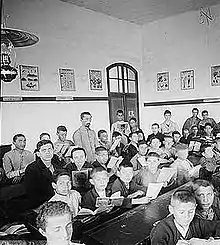

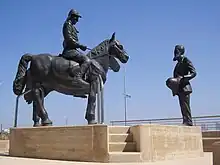
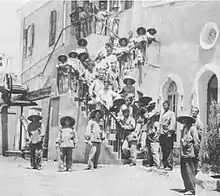
History
Mikveh Israel was founded in the Mutasarrifate of Jerusalem, Ottoman Empire in April 1870 by Charles Netter, an emissary of the French organization Alliance Israélite Universelle, aiming to be an educational institution where young Jews could learn agriculture and leave to establish villages and settlements all over the country and to make the desert blossom. It was established on a tract of land southeast of Jaffa leased from the Ottoman Sultan, who allocated 750 acres (3.0 km2) to the project.[3] The name is taken from two passages in the Book of Jeremiah, Jeremiah 14:8 and 17:13, and was proposed by Wolf Grinstein, one of the school's first students, who later taught there.
Netter, the first headmaster, introduced new methods of agricultural training, with Baron Edmond James de Rothschild contributing to the upkeep of the school. Netter pioneered progressive educational methods and a new way of life and agricultural training to the future farmers of this land. There were only about 20,000 Jews in the country at that time, mostly established in the traditional cities of Judaism: Jerusalem, Tiberias, Safed and Hebron.
Beginning in the early 1880's the school was used to train the first group of farm workers in order to ready an eventual self sustaining village in the area. The project was mostly funded by the French Baron de Rothschild who would only purchase the land in loan, after the farmers had proven that they were properly trained. The men were each established farm workers who were from the Russian village of Pavaluka, and on November 7, 1883 the ten chosen farmers had moved to Palestine and plowed the first rows of earth, at what was known as Rishon le-Zion, or first to Zion, in English.[4]
In 1898, Theodor Herzl met the German Emperor Wilhelm II at the main entrance of Mikveh Israel during Herzl's only visit to Eretz Yisrael.[5] The meeting, a PR event engineered by Herzl to publicly meet the Kaiser, was misinterpreted by the world media as a legitimization of Herzl and Zionism by Germany. [6] Today, entrance to the school grounds is via the city of Holon.[3]
For many decades (until the establishment of the Volcani Center and the Faculty of Agriculture in Rechovot) the school served as the research center for the country. Their teachers wrote the first study books about agriculture and served as field advisors. Most of the agricultural know-how of the first 50 years was collected and published by Mikve Israel. After finishing their studies, the thousands of graduates left Mikve Israel to start agricultural settlements of all kinds, villages and kibbutzim, moshavim, farms and agricultural schools; or serving in management positions; or continued their agricultural studies in institutions of higher learning and filling positions in research and development, the export branches, marketing and agricultural management.
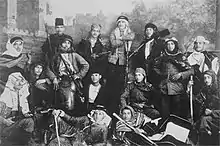
In 1938–1939, at the request of the Youth Aliyah, a section for religious youth was built to house the religious and traditional youngsters who fled western Europe just before the start of the Holocaust.
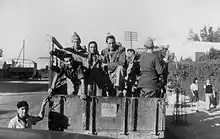
Geography
Mikve Israel is located on a strategic crosspoint on the road connecting Tel Aviv to Jerusalem. Part of the only green space in Tel Aviv District, it has been used as an organizing point for the convoys and up to the Gulf War.
Education
The village has about 1,800 pupils from the age of 12 to the age of 18; 800 in the General section, 320 in the religious school, 380 in the French-Israeli college and high school. Around 280 students are boarders and the site also hosts four Montessori and holistic pedagogy kindergartens, and a Montessori elementary school.
In 2007 Mikve Israel and the Alliance Israélite Universelle inaugurated an experimental bilateral Israel-France high school, with half of its pupils studying for the French Baccalauréat and half for Israeli Bagrut. It is the Collège-Lycée franco-israélien Raymond Leven (Hebrew: בה"ס ישראלי-צרפתי ע"ש רמונד לאוון.[7] It serves up to the final year of senior high school.[8]
Agriculture
The agricultural grounds of Mikve Israel cover over 2,200 dunams (out of a general area of 3,300 dunams). Most of the fields are irrigated using wells and include field crops, industrial crops, vegetables, fruit trees, orange groves and greenhouses. The school also raises animals including milk cows, chickens and honey bees, as well as having auxiliary branches including computerized agriculture.
One dunam (0.1 hectares) is covered by greenhouses. The aim of the greenhouse production branch is to teach students and allow them to research greenhouse issues and technologies. A rainwater harvesting system allows efficient re-use of water collected from the roof for growing of vegetables in greenhouses.
Gardening and landscaping activity over 100 dunams (10 hectares) includes woods, lawns and beauty & leisure gardens and spots throughout the village. The gardening and landscaping is maintained by the students supervised and coached by the manager of this production branch.
The botanical garden was established in 1930 in order to adapt and acclimate trees and species to the Israeli climate. Plants were imported from all over the world. It now covers now 70 dunams (7 hectares).
The dairy farm covers as genetics, computers, milking parlor and cooling, product quality control, feeding, herd health, udder health, artificial insemination and embryo transfer and implants.
The stable has the following breeds of riding horses: Hanoverian, Holland and quarter-horse breeds suited to all types of horseback riding: western, sports, and therapeutic riding.
Notable alumni
- David Tabak (1927–2012), Olympic runner
- Avraham Yoffe (1913-1983), Soldier, Head of the Nature Preservation Society, politician
See also
References
- "Regional Statistics". Israel Central Bureau of Statistics. Retrieved 22 February 2023.
- Raphael Patai (1971) Mikve Israel Encyclopedia of Zionism and Israel, 1971
- Mikve Israel Agricultural School Archived 2009-04-16 at the Wayback Machine Go Israel
- "The Start of the Baron's Activities in Eretz Israel".
- First Agricultural School - Mikveh Yisrael (1870) Shimur
- Reverend William H. Hechler - The Christian minister who legitimized Theodor Herzl by Jerry Klinger. Jewish Magazine, July 2010
- "La localisation." Collège-Lycée franco-israélien Raymond Leven. Retrieved on 22 January 2015. "Agricultural School Mikve Israel Mikve israel street 1 5891000 Holon - ISRAEL" - Address in Hebrew: "בה"ס חקלאי מקווה ישראל 5891000 חולון"
- "SECTION FRANCAISE." Collège-Lycée franco-israélien Raymond Leven. Retrieved on 22 January 2015.